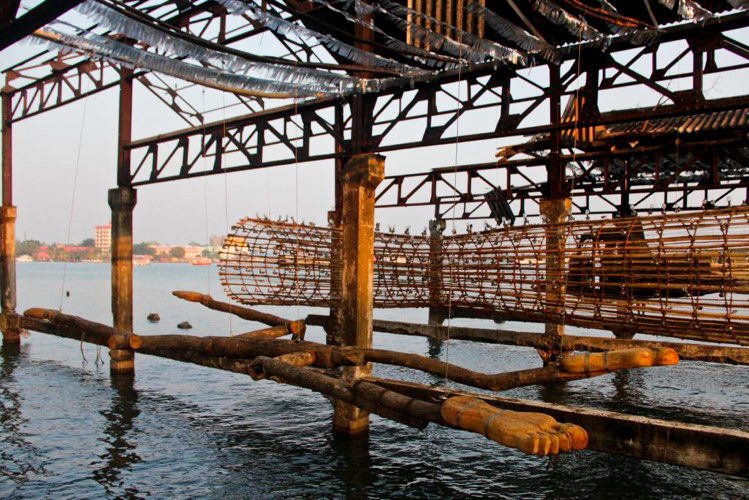“Kappiri” shrines in the coastal regions of Kerala and the local legends surrounding their worship can give us fresh insight into Indian Ocean slave trade and the lesser-known aspects of Portuguese colonialism in Kerala.
Neelima Jeychandran

Most people in Kerala do not know about coastal Kerala’s African connection. While Kerala’s cultural connections with Europe are well articulated through literature, museums and heritage sites, linkages with Africa and the forced migration of Africans to the Malabar Coast remain obscure and are recalled primarily through rituals and folklore.
In the coastal regions of Kochi (Cochin) and Thrissur in Kerala, memories of forced African migration towards the southwestern Indian ports are preserved through shrines dedicated to deceased Africans or Kappiris (“black persons”). These African sacred spaces are carved and maintained by mortal beings mostly hailing from the coastal subaltern communities and they are perpetually protected by African spirit beings. While there are a few wayside shrines dedicated to the Kappiris, a majority of them are found in Hindu sacred groves or

In Malayalam, Kappiri means “black person” and Kappirikkal means “Black people.” The word Kappiri is a dialectical variant of the word kaffir, derived from the Arabic word kafr, denoting infidel or nonbeliever, that has been extended by Arabs to mean “non-Muslim Africans” more generally. The racially loaded meaning of the word, and its derogatory usage in the past to address a black person–especially an enslaved African–remains largely unknown to the local coastal population. For most local people, Kappiri is a spectral deity, figureless and seemingly abstract; a pervasive spirit who inhabits anywhere in the coastal landscape of Kochi. They are benevolent spirits who embody a host of ambivalences about brutalities of the past and insecurities of the present.
Even though mainstream discourses on colonial Cochin have neglected the arrival, survival, and violent murder of Africans during the Portuguese and Dutch rule of Kerala, the prevalent worship of Kappiri spirits sustains these lesser-known histories in the form of local lore. While there are several local stories about Africans in coastal Kerala, most locals say that Africans were brought to the Malabar Coast as slaves by the Portuguese to work as deckhands and to perform manual labour in their forts and factories. A familiar version recounts that after the Dutch takeover of Cochin, the retreating Portuguese buried their possessions in pits and murdered enslaved Africans because of superstitious beliefs that the Africans’ spirits would protect the treasure. Locals also believe that Kappiri watches over abandoned colonial treasure and, when pleased with someone, can offer them riches, as if in reward for remembering and recognizing the burdened collective past that he signifies. Reflecting on this local myth, one of my Fort Kochi interlocutors, Kunnathevedu Cheku Augustine, a 60-year old local carpenter remarked that it is because of the violent manner in which Africans were killed that their spirits lurk in the coastal landscape of Kochi.

The figure of the Kappiri manifests its presence in Kerala in interesting ways. In the form of a spirit, it thrives as living history for working-class people who look to the Kappiri for guidance, healing, and protection. Kappiri is also remembered through stories told of his sightings along the borders or at the thresholds in Kochi, and in contemporary novels, films, and also through works of visual art. Ironically, while European histories are monumentalized in postcolonial India, histories of enslaved Africans, though buried, are preserved through alternative processes of cultural conservation including rituals and beliefs directed toward Kappiri.
About the Author: Neelima Jeychandran is a postdoctoral researcher and teaching fellow with a joint appointment in the Department of Asian Studies and African Studies Program at the Pennsylvania State University. She is a scholar of the Indian Ocean World who studies sacred geographies, material cultures, migrant communities, and mobilities to understand transcultural exchanges between Africa and Asia.

I had tried to cover this subject extensively in an earlier article some years ago, titled THE KAPPIRI SLAVES OF COCHIN
https://maddy06.blogspot.com/2015/02/the-kappiri-slaves-of-cochin.html
Those interested my peruse it for further information
Can I get a contact number of Neelima Jayachandran? As my field of research and her domain of work appears to coincide, I wish to interact with her. That would prove very helpful. Thankyou.
Good effort. Usually MangattuKavu KaaPiri “thara” picture is the one that goes with a usual KaaPiri article. Thanks to you and the locals who took you to the one pictured here. As a local, I find it very nostalgic and heartwarming to see efforts to keep our Kaapiris’ memory alive, who were very much so, before electricity started lighting up our nights.
Awesome and knowledgeable writing.
Keep it up.
Regards.